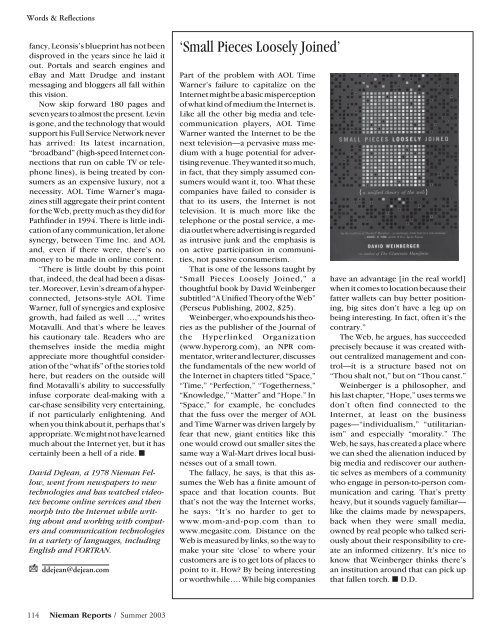summer-2003-Part 2-live - Nieman Foundation - Harvard University
summer-2003-Part 2-live - Nieman Foundation - Harvard University
summer-2003-Part 2-live - Nieman Foundation - Harvard University
- No tags were found...
Create successful ePaper yourself
Turn your PDF publications into a flip-book with our unique Google optimized e-Paper software.
Words & Reflectionsfancy, Leonsis’s blueprint has not beendisproved in the years since he laid itout. Portals and search engines andeBay and Matt Drudge and instantmessaging and bloggers all fall withinthis vision.Now skip forward 180 pages andseven years to almost the present. Levinis gone, and the technology that wouldsupport his Full Service Network neverhas arrived: Its latest incarnation,“broadband” (high-speed Internet connectionsthat run on cable TV or telephonelines), is being treated by consumersas an expensive luxury, not anecessity. AOL Time Warner’s magazinesstill aggregate their print contentfor the Web, pretty much as they did forPathfinder in 1994. There is little indicationof any communication, let alonesynergy, between Time Inc. and AOLand, even if there were, there’s nomoney to be made in online content.“There is little doubt by this pointthat, indeed, the deal had been a disaster.Moreover, Levin’s dream of a hyperconnected,Jetsons-style AOL TimeWarner, full of synergies and explosivegrowth, had failed as well …,” writesMotavalli. And that’s where he leaveshis cautionary tale. Readers who arethemselves inside the media mightappreciate more thoughtful considerationof the “what ifs” of the stories toldhere, but readers on the outside willfind Motavalli’s ability to successfullyinfuse corporate deal-making with acar-chase sensibility very entertaining,if not particularly enlightening. Andwhen you think about it, perhaps that’sappropriate. We might not have learnedmuch about the Internet yet, but it hascertainly been a hell of a ride. ■David DeJean, a 1978 <strong>Nieman</strong> Fellow,went from newspapers to newtechnologies and has watched videotexbecome online services and thenmorph into the Internet while writingabout and working with computersand communication technologiesin a variety of languages, includingEnglish and FORTRAN.ddejean@dejean.com‘Small Pieces Loosely Joined’<strong>Part</strong> of the problem with AOL TimeWarner’s failure to capitalize on theInternet might be a basic misperceptionof what kind of medium the Internet is.Like all the other big media and telecommunicationplayers, AOL TimeWarner wanted the Internet to be thenext television—a pervasive mass mediumwith a huge potential for advertisingrevenue. They wanted it so much,in fact, that they simply assumed consumerswould want it, too. What thesecompanies have failed to consider isthat to its users, the Internet is nottelevision. It is much more like thetelephone or the postal service, a mediaoutlet where advertising is regardedas intrusive junk and the emphasis ison active participation in communities,not passive consumerism.That is one of the lessons taught by“Small Pieces Loosely Joined,” athoughtful book by David Weinbergersubtitled “A Unified Theory of the Web”(Perseus Publishing, 2002, $25).Weinberger, who expounds his theoriesas the publisher of the Journal ofthe Hyperlinked Organization(www.hyperorg.com), an NPR commentator,writer and lecturer, discussesthe fundamentals of the new world ofthe Internet in chapters titled “Space,”“Time,” “Perfection,” “Togetherness,”“Knowledge,” “Matter” and “Hope.” In“Space,” for example, he concludesthat the fuss over the merger of AOLand Time Warner was driven largely byfear that new, giant entities like thisone would crowd out smaller sites thesame way a Wal-Mart drives local businessesout of a small town.The fallacy, he says, is that this assumesthe Web has a finite amount ofspace and that location counts. Butthat’s not the way the Internet works,he says: “It’s no harder to get towww.mom-and-pop.com than towww.megasite.com. Distance on theWeb is measured by links, so the way tomake your site ‘close’ to where yourcustomers are is to get lots of places topoint to it. How? By being interestingor worthwhile…. While big companieshave an advantage [in the real world]when it comes to location because theirfatter wallets can buy better positioning,big sites don’t have a leg up onbeing interesting. In fact, often it’s thecontrary.”The Web, he argues, has succeededprecisely because it was created withoutcentralized management and control—itis a structure based not on“Thou shalt not,” but on “Thou canst.”Weinberger is a philosopher, andhis last chapter, “Hope,” uses terms wedon’t often find connected to theInternet, at least on the businesspages—“individualism,” “utilitarianism”and especially “morality.” TheWeb, he says, has created a place wherewe can shed the alienation induced bybig media and rediscover our authenticselves as members of a communitywho engage in person-to-person communicationand caring. That’s prettyheavy, but it sounds vaguely familiar—like the claims made by newspapers,back when they were small media,owned by real people who talked seriouslyabout their responsibility to createan informed citizenry. It’s nice toknow that Weinberger thinks there’san institution around that can pick upthat fallen torch. ■ D.D.114 <strong>Nieman</strong> Reports / Summer <strong>2003</strong>
















